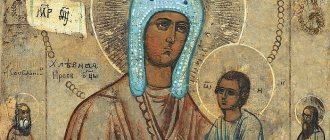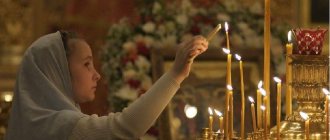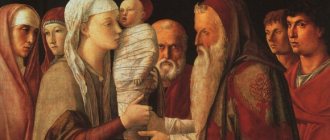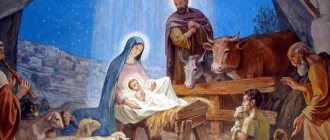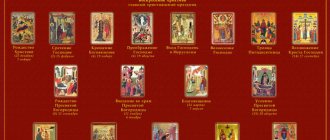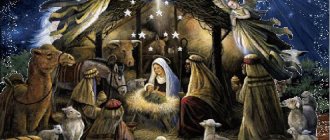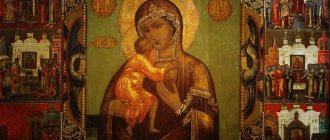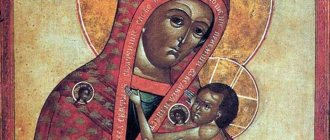The Nativity of Christ is a great event in the life of our world. The Lord came down to earth to atone for original sin and lead humanity to salvation.
Christmas has become the largest holiday of the Christian religion.
“The Nativity of Christ” by Andrei Rublev has become one of the most famous Orthodox icons, a real treasure of Orthodox icon painting, a role model for all Orthodox icon painters
Description of the image
“The Nativity of Christ” is a unique iconographic monument. Every plot element matters:
- The Virgin Mary is dressed in a red maforium, depicted in the center and is the largest figure;
- Baby Jesus is the smallest figure, but is depicted twice. In a dark cave He lies in a manger, wrapped in white swaddling clothes. The darkness of the cave symbolizes the spiritual darkness of paganism, and the snow-white diaper symbolizes the enlightenment that the Savior brought to the world. In the lower right corner there is a scene of His washing - a symbol of the rite of baptism;
- Magi - three wise men from the East mean pagans going to the light of the Star of Bethlehem, to spiritual purification. Their gifts also contain symbolism: incense means God, gold - the King, myrrh - the coming death. The different ages of the Magi symbolize youth, maturity and old age. The young man was the first to approach the newborn. The meaning of this sequence is that you can come to faith at any age. But it is easier to keep a young soul unsullied than to cleanse oneself of sins committed throughout one’s life;
- angels are messengers of the will of the Lord, a symbol of the union of the material and divine worlds;
- shepherds - the Jewish people, like the pagan ones, are moving towards the light of Christianity. The image of angels next to shepherds means that simple, unenlightened people have an open heart. Therefore, it is easier for them to believe in the miracle of God’s incarnation. They are opposed by the learned Magi - the mind turned to material things. It hardens the heart and demands proof of the existence of God.
The icon also contains a symbol of temptation - Joseph and an unknown man dressed in the skin of a goat. Researchers see a demon in the figure of the stranger. He inspires Joseph with the idea of the sinfulness of the Virgin Mary. The betrothed husband would like to part with her, but then, according to ancient custom, she would be stoned to death as an adulteress. This episode is described in the Gospel.
When painting an icon depicting the birth of Jesus Christ, bright colors are used: golden, olive, red. Together we get a festive composition that conveys the solemnity and joy of the moment.
The Nativity of Christ is depicted on a fresco in the Greek temple of Periveleptos in the city of Mystras. It dates back to the 14th century. The earliest plot, dating back to the 2nd century, was discovered in the Roman catacombs of Callista: the Virgin Mary feeds the Baby Jesus, and a prophet stands nearby and points his hand to the Star of Bethlehem. Later, an ox and a donkey, wise men and Persian kings appeared in the plot.
Development of iconography
The first known images associated with Christmas are not about Christmas itself. Here in the center is a fulfilled prophecy. In the center of the composition is the Virgin Mary and Child, in front of them is a prophet pointing to a star. A more detailed description of the events of the Nativity of Christ on icons appears only in the 6th century.
- The Virgin Mary and Jesus lie in the cave.
- There are animals nearby - a donkey, an ox, sometimes sheep. According to legend, Mary was riding on a donkey. Joseph took the ox with him to get money to pay taxes (for this the family went on a journey). Allegorically, the donkey means perseverance, and the ox means hard work.
- A star shines above the cave. Usually depicted in a beam of light. The cave illuminated with light is a symbol of the fact that Christmas enlightened humanity, which was previously in darkness.
- There are scenes around that complement the overall picture: Joseph bowing in prayer, the wise men, angels, shepherds, the scene of the Baby’s bathing.
Using basic elements, masters create an image without going beyond the canonical interpretation. The Church developed the entire doctrine of the Incarnation after the 7th Ecumenical Council. Then the icon painters were able to fully express what had already been formulated in words. The canonical icon not only reminds of the holiday, it serves as a refutation of heresies (for example, Monophysitism).
The appearance of Christ in the flesh is the main event of human history. According to some philosophers, this is its main meaning, which is clearly expressed in the “Nativity of Christ” icon.
Why does the Mother of God look not at her Son, but to the side? She turns her gaze to the wise men who brought expensive gifts to the Lord. The pagans, who were the Magi, symbolize all of humanity. Anyone who wants to give their life to God will be greeted favorably. The scene showing the Baby bathing appeared later. It probably recalls the baptism of infants accepted in Orthodoxy.
Meaning in Orthodoxy
The Nativity of Christ icon is dedicated to one of the main Orthodox holidays and glorifies the triumph of life over death, light over darkness and truth over superstition. On the bright holiday of Christmas, the image inspires believers and directs thoughts to the beginning - the coming of the Son of God to earth and spiritual cleansing.
The icon not only illustrates a biblical event, but also has a meaning similar to the sacrament of the Eucharist. The image gives a feeling of participation in the accomplishment of a miracle, especially when contemplating it in the temple. And this miracle concerns every believer and the entire Christian world as a whole.
The Nativity of Christ is the beginning of a new era, in which the attitude towards Divine and human nature has changed, spiritual values began to prevail over material ones. God incarnate gave new meaning to human existence:
- strive for unity with nature (the Tsar was born not in a palace, but in a cave);
- strive for simplicity in communication and life (walked the earth, had no other wealth except communication with students);
- to eradicate vices in oneself (met with fallen human nature and descended into Hell to give freedom to souls).
As Saint Gregory of Neocaesarea wrote, God descended into the world of people in the guise of a baby, and they became His children.
When was Christ born?
The exact date is hidden from people. January 25 was set arbitrarily by a certain mathematician monk who compiled the Julian calendar. Over time, astronomical “surpluses” accumulated, for two whole weeks. Therefore, the whole world at the end of the 16th century. switched to the more accurate Gregorian calendar. Russia accepted it only in 1918, and the Russian Orthodox Church still lives according to the Julian style.
Therefore, many may have the wrong impression that our country has its own Christmas. No, it falls on the same date, just according to a different calendar. According to a number of researchers, Jesus Christ could not have been born at the end of December, but everything happened in the spring, before the Jewish Passover. In principle, this is not decisive for the salvation of the soul, otherwise the Lord would have preserved the exact date.
Work as a courier at Yandex.Eda (up to 3,400 rubles per shift) leave a request →
In the first centuries of Christianity, people did not celebrate birthdays at all. For them, the most important day was the day of death - this is the date of a person’s birth into eternal life, the day of his union with the Creator. Therefore, the Nativity of the Savior was also not celebrated, or rather, it was combined with the Epiphany. Only years later it was decided to set a separate date for this important event. The holiday became widespread for Christians only in the 4th century; in Russia it began to be celebrated in the 10th century, after the baptism of Prince Vladimir.
History of creation
The most famous Russian image is “The Nativity of Christ” by Andrei Rublev, which is located in the Annunciation Church of the Kremlin in Moscow. The icon was painted in 1405, made on a linden board in the Byzantine style and using tempera technique. The paint is partially damaged, the wood is cracked, but the icon still conveys the author’s intent and is one of the world’s masterpieces.
In his work, Andrei Rublev followed the canonical Byzantine tradition. Therefore, the icon contains a cave, a manger with the Baby Jesus, the Mother of God, the Magi, shepherds and angels. The author depicted the heavenly messengers twice - in the upper right corner and next to the Baby.
The artist reveals the idea that God incarnated on earth for the salvation of people. Using the example of the structure of society of the Roman Empire, it is clear that His creations were mired in vices, and a new Sodom was brewing.
Humanity was experiencing a moral crisis. The author expressed the disunity of social classes by dividing the icon into separate subjects. With the coming of Jesus, faith appeared in people's lives. The Messiah united people from different walks of life, wealth and education.
Fresco by Andrey Rublev
Become a courier of the Yandex.Food service right now (up to 3,400 rubles per shift) leave a request →
Such a plot can also be found among the works of the icon painter A. Rublev. Under the master’s hand, even paints have become a means of expression - he creates space in such a way that it is filled with airy weightlessness, as if all of nature is throwing off the shackles of materiality.
After Christmas, the very meaning of human life changed. People became children of God in the full sense. The King of Heaven took upon himself a corruptible shell. Christ became the second Adam. The earth is no longer a vale of sorrow - after all, the Lord Himself settled on it, who then, with his death on the cross, will open the way to heaven. That's why Angels sing about peace on earth and kindness to people.
Rublev painted the icon of the Nativity of Christ while decorating the Annunciation Cathedral. Much later, they began to make it as an independent item and place it in churches and homes. The image is made in Byzantine traditions. They allow painters to depict several events that happened at different times on one canvas. After all, God has no time limits.
- The angels, who are usually in the upper corner of the composition, in this case worship God right next to the manger. They even show their readiness to accept him into their arms. Of course, the angels at that moment were invisible to the human eye.
- Researchers have different opinions about who is depicted on the Nativity icon next to the righteous Joseph. Some believe that this is a shepherd, some call it the devil, who is trying to sow doubt. However, Joseph's doubts were dispelled even before the journey began by an Angel who appeared to him in a dream. Most likely, this is just one of the shepherds who received an invitation to the newborn Savior.
What do they ask for in front of the icon?
The image of the “Nativity of Christ” has more symbolism than miraculous meaning. It is intended to praise and thank the Lord for the atonement of human sins, for the opportunity to gain eternal life.
People turn to the holiday icon to strengthen the spirit and awaken joy. The image returns to the roots of spiritual purity, reminds of family values, and gives a feeling of heartfelt warmth and light. Therefore, those who are experiencing difficulties in life, are in oppression or are away from home and church can pray in front of the icon.
The Nativity of Christ icon fills the souls of believers with special hope and joy, which they send to the Lord in prayers. And a miracle happens for any need:
- finding family happiness;
- reconciliation of spouses, relatives;
- healing from illnesses;
- receiving financial support.
The Christmas holiday falls at the beginning of the year, so those who are looking for a new path in life, seeking spiritual renewal, redemption and rebirth can turn to the icon.
How to arrange an image in the house
According to Orthodox tradition, a special place is set up for icons - the Red Corner. In the old days, when building a house, first of all, its location was planned - the owner should face the East. Windows were made in the walls forming the Red Corner so that the holy images stood in the most illuminated place of the house.
In modern houses and apartments, a place is allocated for icons in the eastern part of the room. They are located in the living room, bedroom, kitchen. The images are placed on a special multi-tiered shelf - an icon case. A large iconostasis is usually placed in the living room, and individual icons are placed in the remaining rooms.
For a single look, hang a small shelf or place it on a chest of drawers or table. Icons can be hung on the wall, but then it is inconvenient to light candles in front of them, and the paraphernalia will have to be stored separately. In the icon case, icons, lamps, matches and aromatic oils will be collected together.
How to place the iconostasis and single icons:
- separately from decorative items, family photographs;
- do not place a TV or computer nearby;
- do not hang on the wall among paintings;
- can be placed in a niche, alcove with a curtain.
The proximity of icons to books is not desirable. On the table next to the icon you can put the Bible, lives of saints, and a prayer book. But shelves with fiction and specialized literature should not be turned into an iconostasis.
The wrong place for holy images is a wall in the corridor. The icons arranged in a row resemble an art gallery, not a home church. They need a quiet corner, not a busy passage.
The icons on the icon case are arranged in order of seniority from top to bottom:
- on the topmost shelf is the Holy Trinity;
- below are icons of the Mother of God and the Savior, on the sides are images of archangels;
- on the next shelves they place images of the namesake patrons, saints, martyrs and saints.
The icon of the Nativity of Christ can be placed below the icons of the Virgin Mary and Jesus Christ. For decoration, add embroidered white towels and fresh flowers. The rose is a symbol of the Virgin Mary.
Orthodox texts
Before the image of the Nativity of Christ, traditional holiday hymns are read in church and privately.
Troparion
Thy Nativity, Christ our God, arises the worldly light of reason: in it, for those who serve the stars, I study with the star. I bow to You, the Sun of Truth, and I lead You from the heights of the East; Lord, glory to You.
Your Nativity, Christ our God, enlightened the whole world (i.e. people came to know the True God): because then those who served the stars as God (i.e. the Magi) were taught by the star to worship You, the Sun of righteousness (as the prophets called the coming Savior of the world), and to know You, the East, from above (this is what the ancient prophets called Christ, God is called the East, because He is the Beginning of the world, the Beginning of life). Lord, glory to You!
Kontakion
The Virgin today gives birth to the Most Essential, and the earth brings a den to the Unapproachable; Angels and shepherds praise, while wolves travel with a star; For our sake, the Young Child was born, the Eternal God.
Today the Virgin gives birth to the One who is above all created things, and the earth brings a cave to the One Who cannot be approached. Angels and shepherds glorify God, but the wise men travel with the star, because for us a Child was born, who is the Eternal God.
Greatness
We magnify You, Life-Giving Christ, for our sake now born in the flesh from the brideless and Most Pure Virgin Mary.

